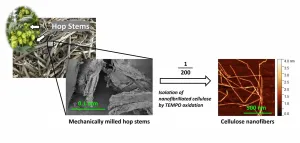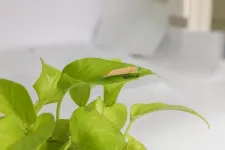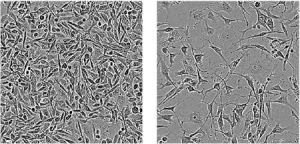Waste hop stem in the beer industry upcycled into cellulose nanofibers
2021-07-02
(Press-News.org) Some three quarters of the biomass in hop plants used in beer-making ends up in landfills. But a group of Japanese researchers has developed a technique that 'upcycles' that waste hop into cellulose nanofibers (CNFs). A paper describing the technique was published in the journal ACS Agricultural Science & Technology on June 11.
In the past few years, craft beer-making has exploded in popularity around the world, including many beer styles that make use of many more and different types of hops than conventional commercial beers. A traditional preservative in beer, hops also add a rich bitterness and impart floral or citrus aromas and flavors. As a result, hop production hit a record high in 2019.
However, only the flower of the hop plant is used in beer making. The stems and leaves, which make up about 75 percent of the biomass produced in hop cultivation, are typically burned or tossed in a landfill after harvest. As some 75% of hop plants end up in landfills, the technique should reduce the beer industry's growing waste and land footprint while also cutting back on petroleum feedstocks.
A group of researchers have developed a technique that 'upcycles' these waste products by using hop stems as raw material to extract CNFs. Since the 2000s, there has been increasing interest in CNFs due to their outstanding properties, including low weight and high strength and stabilization. Thanks to those advantages, CNFs are expected to be used as excellent plant-derived materials for reducing the amount of petroleum based plastics in various industrial applications such as automotive and housing industries as well as food and cosmetic fields.
"This really would deserve a hearty 'cheers' if we managed to reduce dependence on petroleum while also radically reducing the agricultural waste from the beer industry," said Izuru Kawamura, associate professor in the Graduate School of Engineering Science at Yokohama National University and the lead researcher on the project.
CNFs had been extracted successfully from wood and from agro-industrial wastes such as pineapple leaves, banana stems, grapefruit peels, and even spent cofee grounds from cafes.
"But until now, no attempt had been made to isolate CNFs from hop stems," Kawamura added.
Plant cell walls are made of cellulose microfibrils, or very small and slender fibers, in a matrix composed of lignin and hemicellulose. The particular chemical compositions of cellulose, hemicellulose, and lignin vary widely depending on the source of the fibers.
Generally, CNFs are extracted from wood pulp via a series of purification steps followed by refinement via treatment with chemicals or enzymes. Previously, a technique involving application of 2,2,6,6-tetramethylpiperidine-1-oxyl radical (described more simply as 'TEMPO) to pretreated cellulose from wood followed by a gentle mechanical disintegration in water had obtained CNFs of 3-4 nanometers in width.
The researchers used the TEMPO technique, but also reduced the pretreatment processes for removing lignin and hemicellulose in hop stems which is considered as lignocellulose fibers prior to the TEMPO step. Even without the pretreatments, they could obtain CNFs with a median of about 2 nanometers. Using the chemical composition analysis, they were able to conclude that the hop stems contained a proportion of cellulose that is almost equal in proportion to that of wood.
This means that not only could this technique replace petroleum, but in a third environmental win, hop waste could also be used instead of wood as an alternative source for CNFs.
"You might even say 'three cheers' for CNFs from hops."
As a next step, the team wants to actually prepare some emulsions stabilized by hop stem-derived CNFs and demonstrate to industry their feasibility. If successful, they should lead to a significant reduction in the amount of conventional synthetic surfactants used.
INFORMATION:
Yokohama National University (YNU or Yokokoku) is a Japanese national university founded in 1949. YNU provides students with a practical education utilizing the wide expertise of its faculty and facilitates engagement with the global community. YNU's strength in the academic research of practical application sciences leads to high-impact publications and contributes to international scientific research and the global society. For more information, please see: https://www.ynu.ac.jp/english/
[Attachments] See images for this press release:

ELSE PRESS RELEASES FROM THIS DATE:
2021-07-02
Berkeley -- Many insects and spiders get their uncanny ability to scurry up walls and walk upside down on ceilings with the help of specialized sticky footpads that allow them to adhere to surfaces in places where no human would dare to go.
Engineers at the University of California, Berkeley, have used the principle behind some of these footpads, called electrostatic adhesion, to create an insect-scale robot that can swerve and pivot with the agility of a cheetah, giving it the ability to traverse complex terrain and quickly avoid unexpected obstacles.
The robot is constructed from a thin, layered material that bends and contracts when an electric voltage is applied. In a 2019 paper, the research team demonstrated that this simple ...
2021-07-02
Wander around a desert most anywhere in the world, and eventually you'll notice dark-stained rocks, especially where the sun shines most brightly and water trickles down or dew gathers. In some spots, if you're lucky, you might stumble upon ancient art - petroglyphs - carved into the stain. For years, however, researchers have understood more about the petroglyphs than the mysterious dark stain, called rock varnish, in which they were drawn.
In particular, science has yet to come to a conclusion about where rock varnish, which is unusually rich in manganese, comes from.
Now, scientists at the California Institute of Technology, the Department of Energy's SLAC National Accelerator ...
2021-07-02
Neuroscientists at the University of Massachusetts Amherst have demonstrated in new research that dopamine plays a key role in how songbirds learn complex new sounds.
Published in the Journal of Neuroscience, the finding that dopamine drives plasticity in the auditory pallium of zebra finches lays new groundwork for advancing the understanding of the functions of this neurotransmitter in an area of the brain that encodes complex stimuli.
"People associate dopamine with reward and pleasure," says lead author Matheus Macedo-Lima, who performed the research in the lab of senior author Luke Remage-Healey as a Ph.D. student in UMass Amherst's Neuroscience and Behavior graduate program. "It's a very well-known concept that dopamine is involved in learning. ...
2021-07-02
In cancer research, it's a common goal to find something about cancer cells -- some sort of molecule -- that drives their ability to survive, and determine if that molecule could be inhibited with a drug, halting tumor growth. Even better: The molecule isn't present in healthy cells, so they remain untouched by the new therapy.
Plenty of progress has been made in this approach, known as molecular targeted cancer therapy. Some current cancer therapeutics inhibit enzymes that become overactive, allowing cells to proliferate, spread and survive beyond ...
2021-07-02
What The Study Did: Researchers in this study aimed to determine how each state and the District of Columbia planned to ensure equitable COVID-19 vaccine distribution.
Authors: Juan C. Rojas, M.D., of the University of Chicago, is the corresponding author.
To access the embargoed study: Visit our For The Media website at this link https://media.jamanetwork.com/
(doi:10.1001/jamanetworkopen.2021.15653)
Editor's Note: The article includes conflict of interest and funding/support disclosures. Please see the article for additional information, including other authors, author contributions and affiliations, conflict of interest and financial ...
2021-07-02
What The Study Did: Changes in the use of women's preventive health services during the COVID-19 pandemic, including screening for sexually transmitted infections, breast and cervical cancer, and obtaining contraceptives from pharmacies are described by researchers in this study.
Authors: Nora V. Becker, M.D., Ph.D., of the University of Michigan Medical School in Ann Arbor, is the corresponding author.
To access the embargoed study: Visit our For The Media website at this link https://media.jamanetwork.com/
(doi:10.1001/jamahealthforum.2021.1408)
Editor's Note: The article includes conflict of interest disclosures. Please see the article for additional information, including other authors, ...
2021-07-02
What The Study Did: Researchers estimated the frequency and magnitude of surprise bills for deliveries and newborn hospitalizations, which are the leading reasons for hospitalization in the United States, to illustrate the potential benefits of federal legislation that will protect families from most surprise bills. Potential surprise bills were defined as claims from out-of-network clinicians and ancillary service providers, such as an ambulance.
Authors: Kao-Ping Chua, M.D., Ph.D., of the University of Michigan Medical School in Ann Arbor, is the corresponding author.
To access the embargoed study: Visit our For The Media website at this link https://media.jamanetwork.com/
(doi:10.1001/jamahealthforum.2021.1460)
Editor's Note: The article includes conflict of ...
2021-07-02
What The Study Did: This study investigates whether different risk factors identify the same hospitals caring for a high proportion of disadvantaged patients using seven definitions of social risk.
Authors: Susannah M. Bernheim, M.D., M.H.S., of the Yale University School of Medicine in New Haven, Connecticut, is the corresponding author.
To access the embargoed study: Visit our For The Media website at this link https://media.jamanetwork.com/
(doi:10.1001/jamahealthforum.2021.1323)
Editor's Note: The article includes conflict of interest and funding/support ...
2021-07-02
PHILADELPHIA-- While more women are entering the field of academic medicine than ever before, they are less likely to be recognized as experts and leaders; they are less likely to receive prestigious awards, be promoted to full professorships, hold leadership roles, or author original research or commentaries in major journals. What's more, articles published by women in high-impact medical journals also have fewer citations than those written by men, especially when women are primary and senior authors, according to new research from the Perelman School of Medicine and the Leonard Davis Institute of Health Economics at the University of Pennsylvania, published today in JAMA Open Network.
Researchers found that of the 5,554 articles published in 5 leading academic medical journals ...
2021-07-02
The Mutriku wave power plant was built on the Mutriku breakwater, a site with great wave energy potential, and has been in operation since 2011. With 14 oscillating water columns to transform wave energy, it is the only wave farm in the world that supplies electricity to the grid on a continuous basis. In general, technologies that harness the power of the waves to produce electricity are in their infancy, and this is precisely what is being explored by the UPV/EHU's Research Group EOLO, which focusses on Meteorology, Climate and Environment, among many ...
LAST 30 PRESS RELEASES:
[Press-News.org] Waste hop stem in the beer industry upcycled into cellulose nanofibers




